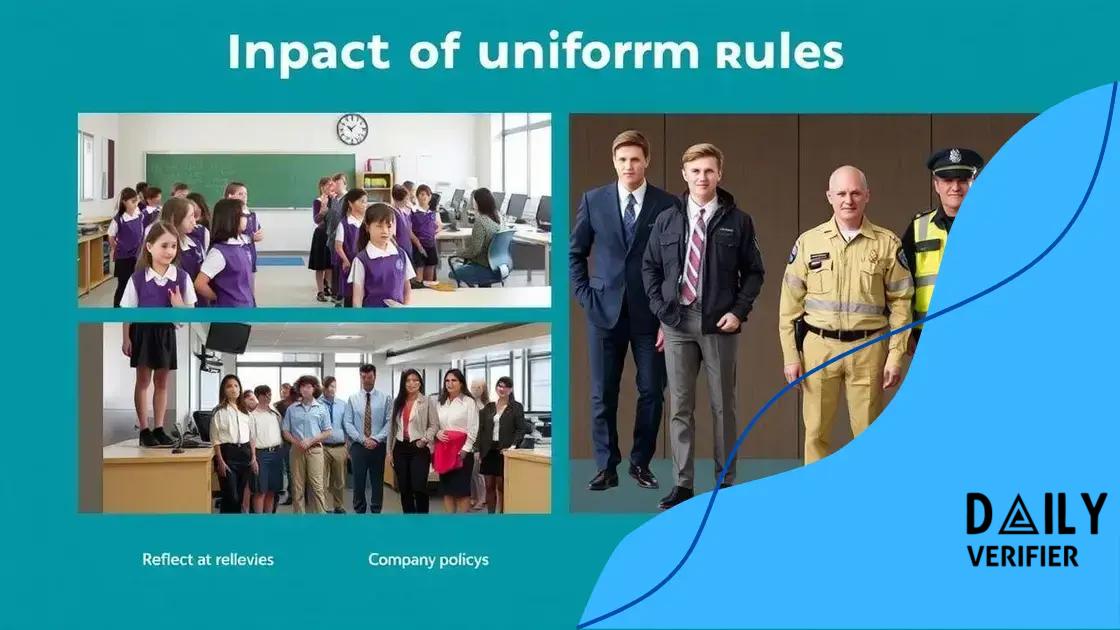Uniform rules cause stir in daily life and work

Uniform regulations shape behavior and perceptions in schools and workplaces, reflecting societal values while evolving through community feedback and technological advancements.
Uniform rules cause stir in various aspects of life, from workplaces to schools. Have you noticed how these regulations affect interactions and routines? Let’s delve into their influence and what it means for us.
Understanding the impact of uniform rules
Understanding the impact of uniform rules is essential in today’s society. These regulations aren’t just about compliance; they influence how we interact, work, and learn.
Effects on Different Sectors
Uniform rules can create a sense of order, but they also stir debate. For example, in schools, uniform rules promote discipline and equality among students.
On the other hand, they can stifle individual expression. It’s important to weigh both sides.
- Positive Effects: Enhanced cooperation, reduced conflicts, and a clear structure for behavior.
- Negative Effects: Potential disregard for individuality and creativity.
- Community Feedback: Input from stakeholders can shape effective rules.
In workplaces, uniform rules set clear expectations and help in establishing a shared culture. However, they can be too rigid, leading to discontent among employees who crave flexibility.
Personal Experiences
Many individuals report feeling constrained by rigid uniform rules. For instance, students express frustration when their clothing choices are limited, impacting their self-identity.
Conversely, some appreciate the guidelines that uniforms offer, as they can foster a sense of belonging. Balancing these perspectives is crucial for creating effective policies.
In communities, uniform rules promote safety and order. However, they can also lead to feelings of alienation if not well thought out. Ensuring that everyone’s voice is heard plays a vital role in establishing effective regulations.
Ultimately, the impact of uniform rules is multifaceted. It is essential to consider both their positive and negative aspects, incorporating various perspectives to foster an inclusive approach.
Controversies sparked by uniform rules
Controversies sparked by uniform rules can often lead to heated discussions. These rules can affect many aspects of life, especially in schools and workplaces.
Discussions in Schools
Uniform rules in schools are often a topic of debate. While some believe these rules enforce discipline, others argue they hinder personal expression.
- Supporters argue that uniforms create a better learning environment.
- Opponents believe they suppress individuality.
- Both sides present valid points that deserve consideration.
Many students feel that being forced to wear certain uniforms takes away their freedom. This conflict between regulation and self-expression can create tension among students, parents, and school administrators.
Uniform Rules in the Workplace
In the workplace, uniform rules can also spark controversy. Employees may perceive these rules as a lack of trust in their professionalism. Additionally, uniform policies might not account for personal comfort and individual styles.
Consider these points:
- Employee morale: Strict uniforms may affect how employees feel about their jobs.
- Productivity: Some argue that comfort increases productivity, suggesting flexibility might be beneficial.
- Brand image: Companies often implement uniforms to project a professional image.
The discussions around uniform rules highlight the balance between order and individuality. Finding a middle ground can help minimize conflicts and enhance workplace or school culture.
Real-life examples of uniform rules affect

Real-life examples of how uniform rules affect various environments can provide valuable insights. These rules often shape interactions in schools, workplaces, and even community settings.
Schools Implementing Uniforms
Many schools have adopted uniforms as a way to promote equality among students. For instance, schools in urban areas often see a significant reduction in bullying when all students wear the same outfit.
- Example 1: A school in New York reported a drop in incidents related to dress code violations.
- Example 2: An elementary school in California saw improved student focus and engagement after introducing uniforms.
- Example 3: Schools in uniform programs often report increased school spirit and pride.
This illustrates how uniform rules can create a sense of belonging and reduce distractions, allowing students to focus on learning.
Workplace Policies
In the workplace, different companies have adopted uniform policies to maintain a professional image. For example, tech companies may allow casual attire, while finance firms often enforce business formal standards.
These policies can influence employee morale significantly. Here are a few observations:
- Company A: A law firm that requires formal attire experiences high levels of professionalism.
- Company B: A startup with a relaxed dress code finds that creativity increases among employees.
- Company C: Workers at companies with strict dress codes often report feeling uncomfortable.
This shows that while uniform rules can enhance professionalism, they may also come at the cost of individuality and comfort, affecting job satisfaction.
Lastly, community settings also provide examples. For instance, public safety uniforms help establish respect and authority. Police officers in uniforms are often viewed with a sense of trust and security by the community.
In essence, real-life examples demonstrate that uniform rules are not merely about appearance; they significantly shape behaviors and perceptions across various environments.
The role of community feedback
The role of community feedback is vital in shaping uniform rules. When communities actively participate in discussions about regulations, they can address concerns and create rules that work for everyone.
Importance of Listening to Voices
Listening to community feedback can alter the approach to implementing uniform rules, making it more effective. For instance, when schools involve parents and students in uniform conversations, they often reach a compromise that suits the needs of diverse individuals.
- Example 1: A school district that surveyed parents found they preferred flexibility in dress codes.
- Example 2: Surveys conducted by businesses can reveal employee preferences regarding dress codes.
- Various methods: Town hall meetings, online surveys, and feedback forums can gather valuable input.
These methods encourage open communication. The more inclusive the feedback process, the stronger the acceptance of the rules will be.
Impact of Community Engagement
When communities engage actively, it builds trust. For example, police departments that seek community input on uniform policies foster a stronger relationship with residents. This trust can lead to more cooperation and understanding.
Community feedback helps create a sense of ownership over regulations. People are more likely to support rules they helped shape. This involvement ensures that the uniform rules reflect the community’s values and needs.
Community feedback also highlights areas needing change. If a rule consistently raises concerns, it may need revision to better suit the community.
As communities adapt, feedback mechanisms must evolve. Regularly evaluating how feedback is collected and utilized can lead to positive changes that benefit all members. When communities feel heard, they embrace uniform rules. This dynamic fosters respect and collaboration among all parties involved.
Future implications of uniform regulations
The future implications of uniform regulations are essential to consider as society evolves. These rules will likely adapt to meet the changing needs of communities and workplaces.
Shifting Societal Norms
As social norms shift, uniform regulations may also need to change. For instance, workplaces are increasingly embracing flexibility in dress codes. This trend reflects a broader acceptance of individual expression.
- Remote work: Many companies see the need for less formal attire due to remote work arrangements.
- Inclusivity: There is a growing call for uniform rules that reflect diverse identities.
- Health considerations: Policies around safety and comfort during health crises will impact uniform standards.
This shift may lead to more personalized regulations, respecting the individuality while maintaining basic standards of professionalism.
Community Engagement and Input
Future uniform regulations will likely rely heavily on community feedback. As participation increases, regulations will become more relevant and tailored to the needs of the population.
Active community involvement helps ensure regulations reflect the values and preferences of all stakeholders. This collaborative approach fosters trust and cooperation.
When rules are developed with community input, they are more likely to be accepted and followed. This inclusivity leads to a stronger sense of community ownership over the regulations.
Technological Advances
Technology will play a crucial role in shaping future uniform regulations. As businesses evolve digitally, conventional uniform policies could evolve or diminish.
Online marketplaces and digital brands might shift focus away from physical uniforms, prioritizing branding over traditional dress codes.
The integration of smart technology may also lead to innovative uniform solutions that enhance functionality, comfort, and adaptability.
As a result, the implications of uniform regulations extend well beyond appearances; they fundamentally influence how we interact with each other and our environments.
FAQ – Frequently Asked Questions about Uniform Regulations
Why are community feedback and input important for uniform regulations?
Community feedback ensures that uniform regulations are relevant and accepted, reflecting the values and needs of the population.
How do societal changes influence uniform regulations?
As societal norms evolve, uniform regulations must adapt to meet new expectations for individual expression and inclusivity.
What role does technology play in shaping uniform regulations?
Technology can change how uniforms are perceived and implemented, potentially leading to more personalized and functional designs.
How can organizations find a balance between uniformity and individuality?
Organizations can engage in open dialogue with employees and community members to create rules that respect personal expression while maintaining necessary standards.






